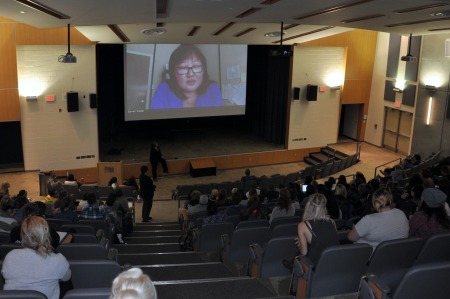
On Oct. 6, students from Niagara College’s Sociology, Social Work and Justice studies programs had an opportunity to participate in a Skype session with Carol Todd. Carol is mother of the deceased Amanda Todd whose YouTube video about how she was bullied, posted just weeks before her suicide, went viral.
You could have heard a pin drop in the Applied Health Institute auditorium.
There was no chatter among students as they watched 15-year-old Amanda Todd’s eight-minute YouTube video, exposing her years of bullying and its severe impact on her life as she spiraled into the depths of depression – with her face only partially shown as she holds up a series of flash cards to share her written message with the world. There were only eyes focused intently on the image of the young teen that left the world too soon.
As the students watched Amanda’s video which has been viewed more than 35 million times globally in the two years since her suicide, Amanda’s mother Carol Todd was, in turn, watching them from the screen of her computer in Vancouver, B.C.
A Skype session organized by professors Theresa Anzovino (Sociology),· Michelle Swaerdens (Community Justice), Jamie Levitt (Liberal Arts and Sciences), and Kimberly Chapman (Social Service Worker), as well as Michelle MacIntosh (counsellor, Student Services), gave NC students studying Sociology in the Social Service Worker, Justice Studies and General Arts and Sciences programs the opportunity to hear from Carol first-hand about the death of her daughter, bullying and mental health.
The event, on October 6, coincided with of a week of on-campus activities to mark the Yellow Umbrella Project, raising awareness about mental health issues. It also came just days before Light Up the World Purple Day on Oct. 10 – the day Amanda took her life and, coincidentally, World Mental Health Day.
Carol – who has been a teacher in Vancouver for 35 years – has been sharing Amanda’s message in the hopes that others will learn from it as part of her Light Up the World Purple Campaign – an anti-bullying campaign marked by her daughter’s favourite colour.
She began by pointing out that, contrary to popular belief, Amanda’s video was not a suicide message.
“When I asked her why she did [the video], she said she needed to tell her story to all the people who cyberbullied her, to get her true story out there so she wouldn’t have to violate herself anymore, and so she did,” said Carol.
Carol spoke about the video, which explains how her daughter was exploited online, and cyberbullied by her peers, victimized by an online predator, and battled depression.
For Carol, the subjects of cyberbullying and mental health should be in focus all year round. She spoke of the idea that everyone is born with some mental health conditions, and it’s what they experience in life that can bring them to the forefront – or not.
“It’s our job to ensure we have safety nets in place for your children, or future children or grandchildren in terms of mental health, in terms of bullying and harassment,” she said. “All the rules and laws will never make it disappear. We need to make sure we embrace kindness and respect, and teach preventable things to make people realize that we truly care about each other in the world.”
Carol spoke about how the same technology that allowed her to speak in real time to Niagara College students from across the country and three time zones away, can make young people and seniors particularly vulnerable to predators online. Children can wake up and discover something they shared has been sent to thousands of people – as her child did.
She noted the importance of privacy settings, watching what one shares online, making sure those who one communicates with online are real people, and knowing that anything that is shared on social media is public.
“We know that all our photos, once we give them to social media, they don’t belong to us anymore. They’re out there for anyone to take,” she said. “What you post on the internet becomes our internet footprint. Our footprints are like concrete. They’re really hard to get rid of once you have laid the ground.”
She pointed out current internet statistics. For example, one out of 25 teens has received online sexual solicitations with the offender seeking to make contact with them online. One out of three teens between 12 and 17 experience cyberbullying and online harassment – and girls are the most likely victims of this form of abuse. While physical bullying has decreased, cyberbullying has increased.
What does cyberbullying have to do with mental health?
“Bullying doesn’t produce the loss of life … it’s the mental health component that rears its ugly head,” she said.
Carol noted how what happens on social media impacts how people feel about themselves and others, as well as how they treat themselves. She spoke about how vital it is to break the stigma, speak about mental health issues and get much-needed support, since – like a cancer— mental health issues can lead to death.
“We shouldn’t have to be without our children sooner than we need to be,” she said.
One of her goals is to bring mental health awareness into even more colleges and universities.
“School can be such a pressure cooker,” she said, noting that her 21-year-old son is currently in his second year of university. “I’m really glad your college is doing the Yellow Umbrella project this week.”
On October 10, 2014, as part of the Yellow Umbrella Project, Niagara College Student Administrative Council representatives handed out purple ribbons to students in memory of Amanda Todd for Light Up the World Purple for World Mental Health Day.

